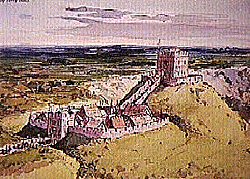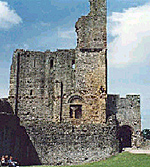 Pre-conquest Anglo-Saxon England was a kingdom that had very few castles. The Anglo-Saxon Chronicles record that there were only three castles of the motte and bailey construction in all of England. These castles had been built by King Edward the Confessorís Norman favorites and were located in southwestern England in the Wessex area. The earliest castles were located in Herefordshire in defense against Welsh intrusion onto the English plain. The scholar, C. Warren Hollister, stated that these three castles were not en oughto stop the Welsh from their raiding into England. The castles maddened the Anglo-Saxons who took out their hatred of these Norman favorites by attacking them on numerous occasions. It is believed that by the time of
Williamís invasion of England, none of the aforementioned castles were manned and that all had
fallen into disrepair. The only fortifications in England at the time of the invasion were Burhs, ringworks and walled cities such as Exeter.
Pre-conquest Anglo-Saxon England was a kingdom that had very few castles. The Anglo-Saxon Chronicles record that there were only three castles of the motte and bailey construction in all of England. These castles had been built by King Edward the Confessorís Norman favorites and were located in southwestern England in the Wessex area. The earliest castles were located in Herefordshire in defense against Welsh intrusion onto the English plain. The scholar, C. Warren Hollister, stated that these three castles were not en oughto stop the Welsh from their raiding into England. The castles maddened the Anglo-Saxons who took out their hatred of these Norman favorites by attacking them on numerous occasions. It is believed that by the time of
Williamís invasion of England, none of the aforementioned castles were manned and that all had
fallen into disrepair. The only fortifications in England at the time of the invasion were Burhs, ringworks and walled cities such as Exeter.
A. Anglo-Saxon Defensive Works
The Anglo-Saxons utilized what is called a burh which is a small community that has an earthen wall surrounding it, with a large wooden watchtower located in the center. This saw its genesis with the arrival of Viking raiders two centuries earlier when the people constructed common defensive works around their villages.
By definition, a burh was a communal defense for all the Anglo-Saxons in a given area. Castles are defined as a fortified home of a feudal lord and were not communal in nature, serving only as a private defensive military base of operations. There were also numerous ringworks, left over from the Celtic time which had later been improved by the Romans due to their strategic locations. Upon Williamís arrival in England, he was faced with numerous walled cities such as the likes of London and Exeter which he did not have the means or manpower to overcome militarily. While these walled cities were almost invulnerable to direct frontal attack by the Norman forces, once put under siege they quickly capitulated because they were not well-provisioned and the population within the wall saw no hope of being relieved by outside forces. In one instance, the walled city of Exeter held out for eighteen days against Williamís forces until it had negotiated certain ancient rights for itself at which time it surrendered.
However, this appears to be the exception, and --had William actually wanted to-- he could have starved the city into submission. It appears that most of the burhs and walled cities fell rather quickly to Williamís forces without much resistance. This can be seen as resulting from the lack of an Anglo-Saxon leader waiting to lead a truly kingdom-wide rebellion against Norman rule. Also, in Williamís favor was that now he had the title of ĎKing of England,í many Anglo-Saxons were willing to embrace his leadership.
Norman Castles
The motte-and-bailey castle is the predecessor of the stone medieval castle we can still view today throughout Europe. This castle was simple to construct and consisted of a wooden fortification wall with a large man-made mound on which a wooden keep was erected to function as the main point of resistance. When William the Conqueror introduced the castle to England during his invasion of that country in 1066, the Anglo-Saxons had very little knowledge about this style of fortification. As is the problem with most new military technologies, it takes time to construct countermeasures; and, in the case of Anglo-Saxon England, their time had run out.
The Norman castle--as stated above-- had been introduced into England by King Edwardís Norman favorites in the 1050s. There were at least three of these at the time of Duke Williamís invasion, but all three had fallen into disrepair and were believed to have been abandoned. The first of these castles --built by Ralf, Earl of Herefordshire-- was located in Herefordshire to counter the Welsh threat to the English plain. There were two other castles also located in Herefordshire that were known of from a passage from the Normannis that stated the following. ďWhen Archbishop Robert and the Frenchmen learnt this, they took their horses and some went west to Pentecostís castle, some north to Robertís castleÖĒ This occurred during Harold Godwinsonís rebellion to drive out the King Norman favorites in 1054.
 The next time we witness the construction of castles on English soil is with the arrival of Williamís invasion force at Pevensey in 1066. Immediately upon taking the town, William had his forces --with the assistance of conscripted Anglo-Saxon laborers-- construct a motte and bailey castle to control the area and provide him with a secure base for further military operations. In both Pevensey and Hastings, William constructed these castle on the ruins of old Roman fortifications and incorporated existing walls into his own castles. Having taken his first English settlement, he moved on to Hastings where again he constructed another motte and
bailey castle to control this town and its associated harbor.
The next time we witness the construction of castles on English soil is with the arrival of Williamís invasion force at Pevensey in 1066. Immediately upon taking the town, William had his forces --with the assistance of conscripted Anglo-Saxon laborers-- construct a motte and bailey castle to control the area and provide him with a secure base for further military operations. In both Pevensey and Hastings, William constructed these castle on the ruins of old Roman fortifications and incorporated existing walls into his own castles. Having taken his first English settlement, he moved on to Hastings where again he constructed another motte and
bailey castle to control this town and its associated harbor.
These castles were critical to the Norman forces because they provided a secure and defensible area to retrograde to if they should encounter superior forces. It also was said that William had brought over the materials with which he constructed the castle at Hastings from Normandy. It can be implied that he had planned to construct these castles in the initial stages of his planning of the invasion, and truly understood their worth in the coming campaign he planned on waging against Haroldís Anglo-Saxon fyrd.
More Role of Castles in William the Conqueror's Victory
-
Introduction
Opposing Forces: Anglo-Saxon and Norman
Battle Of Hastings
Fortifications and Castles in England
Post Hastings Conquest
1067-70, Williamís Kingdom in Peril
Conclusion, Appendix, and References
Back to Cry Havoc #34 Table of Contents
Back to Cry Havoc List of Issues
Back to MagWeb Master Magazine List
© Copyright 2001 by David W. Tschanz.
This article appears in MagWeb (Magazine Web) on the Internet World Wide Web. Other military history articles and gaming articles are available at http://www.magweb.com